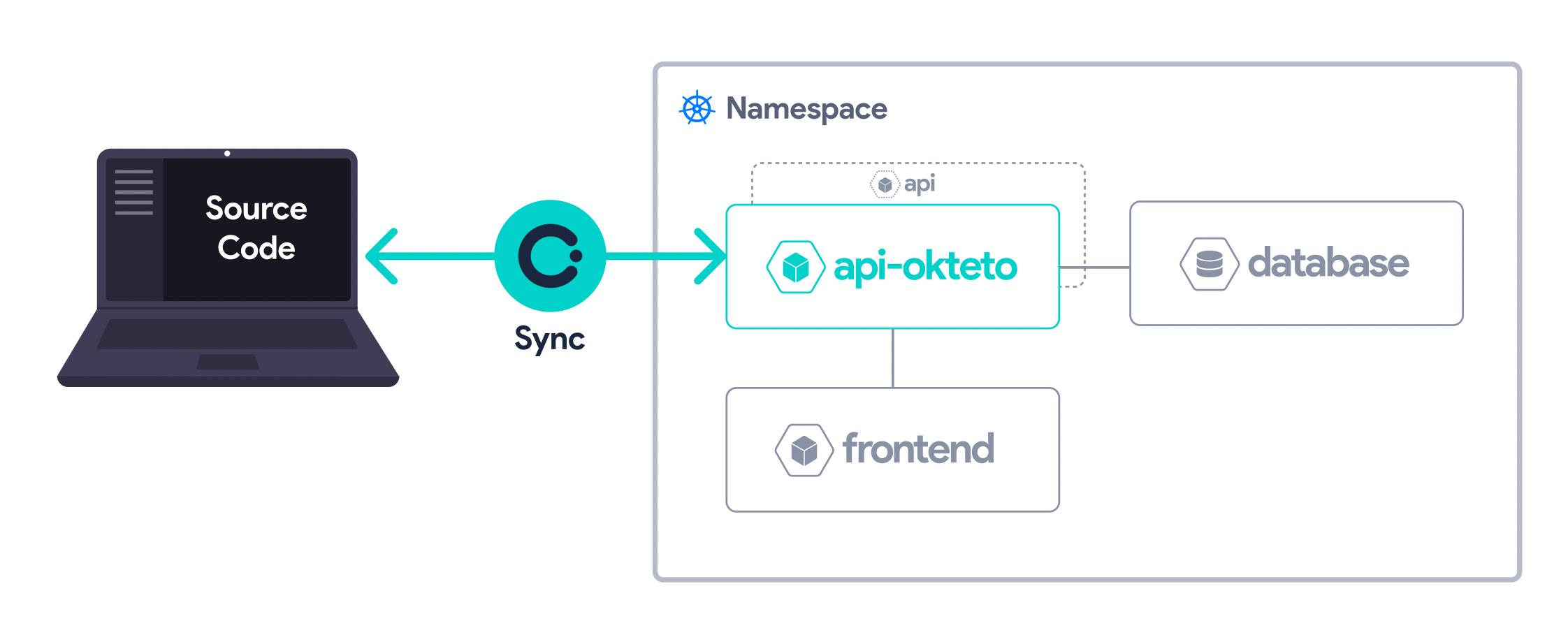Kubernetes has made it very easy to deploy applications to the cloud at a higher scale than ever, but development practices have not evolved at the same speed as application deployment patterns.
Today, most developers try to either run parts of the infrastructure locally or just test their integrations directly in the cluster via CI jobs, or the docker build/redeploy cycle. It works, but this workflow is painful and incredibly slow.
okteto accelerates the development workflow of Kubernetes applications. You write your code locally and okteto detects the changes and instantly updates your Kubernetes applications.
Okteto enables development inside a container, providing a seamless IDE and tool integration as if you were working locally but with the resources of a remote cluster. When you run okteto up your Kubernetes deployment is replaced by a Development Container that contains your development tools (e.g. maven and jdk, or npm, python, go compiler, debuggers, etc). This development container can use any docker image. The development container inherits the same secrets, configmaps, volumes or any other configuration value of the original Kubernetes deployment.
The end result is a remote cluster that is seen by your IDE and tools as a local filesystem/environment. You keep writing code on your local IDE and as soon as you save a file, the change goes to the development container, and your application instantly updates (taking advantage of any hot-reload mechanism you already have). This whole process happens in an instant. No docker images need to be created and no Kubernetes manifests need to be applied to the cluster.
okteto has several advantages when compared to more traditional development approaches:
- Fast inner loop development: build and run your application using your favorite tools directly from your development container. Native builds are always faster than the docker build/redeploy cycle.
- Realistic development environment: your development container reuses the same variables, secrets, sidecars, volumes as your original Kubernetes deployment. Realistic environments eliminate integration issues.
- Replicability: development containers eliminate the need to install your dependencies locally, everything is pre-configured in your development image.
- Unlimited resources: get access to the hardware and network of your cluster when developing your application.
- Deployment independent:
oktetodecouples deployment from development. You can deploy your application with kubectl, Helm, a serverless framework, or even a CI pipeline and useokteto upto develop it. This is especially useful for cloud-native applications where deployment pipelines are not trivial. - Works anywhere:
oktetoworks with any Kubernetes cluster, local or remote.oktetois also available for macOS, Linux, and Windows.
All you need to get started is to install the Okteto CLI and have access to a Kubernetes cluster. You can follow our guide for setting up a Kubernetes cluster on AWS here.
The Okteto CLI has two operational modes:
- Okteto Open Source CLI
- Okteto Platform CLI
Okteto Open Source requires access to a Kubernetes cluster. It's designed to support Development Containers in any Kubernetes cluster. It doesn't come with features that support multiple developers working on the same cluster. That's the goal of the Okteto Platform
Okteto Open Source supports the following commands:
okteto contextokteto upokteto down
For reference, our Open Source CLI supports the dev section of the Okteto Manifest.
We have getting started guides for the Open Source mode for the following languages:
The Okteto Platform CLI requires installation of the Okteto Helm Chart in your Kubernetes cluster. In this mode, all of the Okteto CLI commands are available (build, deploy, up, down, destroy, etc). The Okteto Platform comes with additional features like:
- User authentication and access control to Kubernetes using your own Identity provider
- Build service for remote container image creation
- Preview environments for every pull request
- Dynamic scaling of environments based on usage
- Secrets manager for your development environments
- Okteto Insights to provide observability on your development environments
And much more! Refer to the Okteto Platform docs to learn more.
| Feature | Okteto Open Source CLI | Okteto Platform CLI |
|---|---|---|
| Development Containers | Available | Available |
| Build Service | Not Available | Available |
| User Management | Not Available | Available |
| Access Control | Not Available | Available |
| Automated Scaling | Not Available | Available |
| Secrets Management | Not Available | Available |
| Observability Tools | Not Available | Available |
| Support | Community Support | Professional Support |
| Documentation | Open Source Samples | Platform Docs |
Okteto is monthly released into three channels: stable, beta, and dev. By default when Okteto is installed, the stable channel is used. If you need to access features not yet widely available you can install from the beta or dev channel. More information can be found in the release documentation.
Got questions? Have feedback? Join the conversation in our Community Forum. You can also join us in the #okteto Slack channel! If you don't already have a Kubernetes Slack account, sign up here.
Follow @OktetoHQ on Twitter for important announcements.
We ❤️ contributions big or small. See our guide on how to get started.




